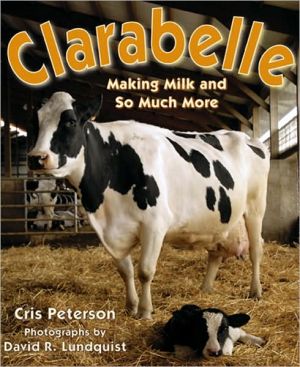

 |

|

The average rating for Clarabelle: Making Milk and so Much More based on 2 reviews is 3 stars.
Review # 1 was written on 2010-06-15 00:00:00 Tom Pat Tom PatFarming has always been a mainstay of children's books. Traditionally, agriculture has presented itself in the fantasy Old MacDonald's Farm-style of picture books such as Cow'even as small farming faded from the landscape. However, frequent exposes of factory farming practices and community battles over the construction of megafarms have made it much more difficult for the food industry to hide behind a rosy image. Thus, we have a troubling new trend exemplified by materials such as Clarabelle: children's stories that whitewash the CAFO and attempt to persuade them that animals are thrilled to be kept in these highly artificial environments. This glossy picture book follows Cow #3557, given the pastoral name of "Clarabelle" for the story. She is one of 1,200 cows on a mega-dairy farm. The text dwells on the pastoral fields that surround the dairy, but the aerial photo makes clear: this is a CAFO and the cows do not graze. The silage that the crowded animals eat instead of grass is called a "daily feast". The text indicates that the cattle eat corn, which offers dense nutrients but also plays havoc with a cow's digestive system. The story begins with Clarabelle and other cows giving birth. Not surprising, as the cycle of pregnancy and birth is central to a dairy cow's life. However, it's also not a coincidence that the calf is never again mentioned after two pages. If it's a female, she'll be raised in a hutch separate from the adult cows. If it's a male, he will be sent to a vealer. Either way, Clarabelle won't get to raise her offspring. CAFOs have been taking heat over environmental pollution as of late, so it's probably not a coincidence that the authors chose a farm that comes with an anaerobic digester that turns manure into electricity. Presumably, this will lessen the chances of a devastating wastewater spill as documented in the recent book Animal Factory . At the same time, one can clearly spot a vast open manure lagoon near the digester'partially cropped out in a corner of the photo. So what's right? Depicting fantasy farms as the source of our food supply, or heavily-whitewashed factory farms in an effort to gain support for a highly controversial method of farming? Ideally, educational materials would tell the facts without an agenda, and allow people'including kids'to make up their own minds. |
Review # 2 was written on 2017-08-17 00:00:00 Kevin Bickford Kevin BickfordThis is an amazingly informative book! |
CAN'T FIND WHAT YOU'RE LOOKING FOR? CLICK HERE!!!